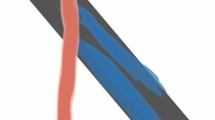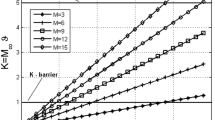Abstract
The problem of determining the slender, hypersonic airfoil shape which produces the maximum lift-to-drag ratio for a given profile area, chord, and free-stream conditions is considered. For the estimation of the lift and the drag, the pressure distribution on a surface which sees the flow is approximated by the tangent-wedge relation. On the other hand, for surfaces which do not see the flow, the Prandtl-Meyer relation is used. Finally, base drag is neglected, while the skin-friction coefficient is assumed to be a constant, average value. The method used to determine the optimum upper and lower surfaces is the calculus of variations. Depending on the value of the governing parameter, the optimum airfoil shapes are found to be of three types. For low values of the governing parameter, the optimum shape is a flat plate at an angle of attack followed by slightly concave upper and lower surfaces. The next type of solution has a finite thickness over the entire chord with the upper surface inclined so that the flow is an expansion. Finally, for the last type of solution, the upper surface begins with a portion which sees the flow and is followed by an inclined portion similar to that above. For all of these solutions, the lower surface sees the flow. Results are presented for the optimum dimensionless airfoil shape, its dimensions, and the maximum lift-to-drag ratio. To calculate an actual airfoil shape requires an iteration procedure due to the assumption on the skin-friction coefficient. However, simple results can be obtained by assuming an approximate value for the skin-friction coefficient.
Similar content being viewed by others
References
Miele, A., Editor,Theory of Optimum Aerodynamic Shapes, Academic Press, New York, 1965.
Donaldson, C. duP., andGray, D. E.,Optimization of Airfoils for Hypersonic Flight, Aerospace Engineering, Vol. 20, No. 1, 1961.
Lewellen, W. S., andMirels, H.,Optimum Lifting Bodies in Hypersonic Viscous Flow, AIAA Journal, Vol. 4, No. 10, 1966.
Miele, A., andLusty, A. H., Jr.,On Optimum Wedges and Semicones in Hypersonic Viscous Flow, AIAA Journal, Vol. 5, No. 1, 1967.
Hull, D. G.,Two-Dimensional, Lifting Wings of Minimum Drag in Hypersonic Flow, Rice University, Aero-Astronautics Report No. 24, 1966.
Hull, D. G.,Two-Dimensional, Hypersonic Wings of Maximum Lift-to-Drag Ratio, Journal of the Astronautical Sciences, Vol. 14, No. 2, 1967.
Weeks, D. E., Jr., andHull, D. G.,Optimum Flat-Top Airfoils in Viscous Hypersonic Flow, Journal of Optimization Theory and Applications, Vol. 5, No. 1, 1970.
Cox, R. N., andCrabtree, L. F.,Elements of Hypersonic Aerodynamics, Academic Press, New York, 1965.
Miele, A.,On the Minimization of the Product of Powers of Several Integrals, Journal of Optimization Theory and Applications, Vol. 1, No. 1, 1967.
Dorrance, W. H.,Two-Dimensional Airfoils at Moderate Hypersonic Velocities, Journal of the Aeronautical Sciences, Vol. 19, No. 9, 1952.
Schlichting, H.,Boundary Layer Theory, Pergamon Press, New York, 1955.
Author information
Authors and Affiliations
Additional information
Communicated by A. Miele
This research was supported in part by the Air Force Office of Scientific Research, Office of Aerospace Research, U.S. Air Force, under AFOSR Grant No. 69-1744.
Rights and permissions
About this article
Cite this article
Thompson, R.A., Hull, D.G. Hypersonic airfoils of maximum lift-to-drag ratio. J Optim Theory Appl 5, 432–448 (1970). https://doi.org/10.1007/BF00927442
Received:
Issue Date:
DOI: https://doi.org/10.1007/BF00927442




